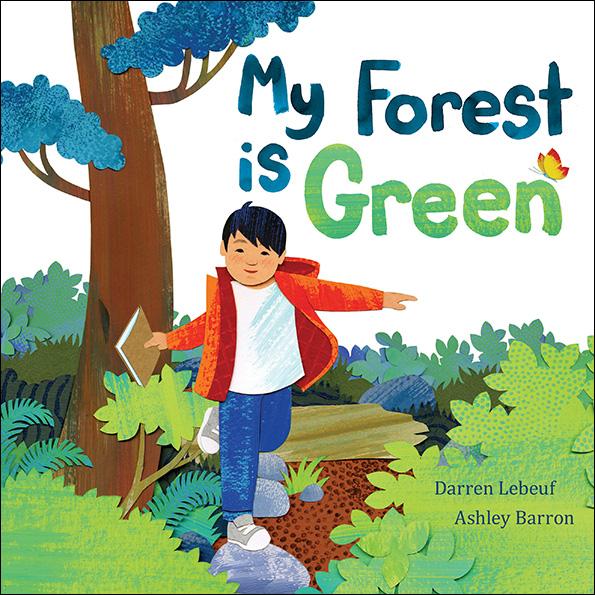
My Forest Is Green
Written by Darren Lebeuf
Illustrated by Ashley Barron
Kids Can Press, 2019, 32 pp
ISBN: 978-1771389303
Darren Lebeuf uses gender-neutral language in My Forest Is Green to describe the delight children experience as they explore their surroundings. In the spirit of the written text, this review remains gender-neutral. This is a story about a child who lives in an apartment in front of a big urban forest. A child spends a lot of time in the forest observing, touching, smelling, listening, and probably tasting, even though it is not explicitly referenced in the story. Though questions are not voiced, the descriptive adjectives invite readers to be curious and ask questions (How does the rain taste as it falls on a drawing?) This child is also an explorer who attentively follows a line of ants as they carry away a pencil (How much weight can an ant carry?), a curious inquirer who hugs trees to perhaps estimate their diameter, and a photographer who has an intricate photo of a caterpillar eating a leaf (How does a caterpillar know which leaves to eat?) It also seems that the child visits the forest throughout different meteorological seasons. That might explain the different clothing: short pants, closed shoes, raincoat, and an interesting trapper or aviator hat/bobble hat! (How does a fox survive extreme cold?)
This child is also an artist, who uses language to describe the forest, “My forest is green. Twisty green, shiny green, jagged green and wavy green” and relies on a range of artistic mediums to bring the forest home. The child’s home is a vivid representation of the colors, lines, shapes, textures, spaces, and designs of nature. Sometimes, the child paints “carefree red” ladybugs or “spotted” turtles. Other times the young ecologist creates a collage to showcase the variety of fallen leaves that make the forest so “crispy.” Many times, the child draws the wonders of the forest in a sketchbook. This notebook depicts a bird singing, a deer posing, and mushrooms (What other animals and plants could live in the urban forest?) The author and the illustrator are from Canada, so this urban forest appears to be located somewhere in Canada, raising questions such as whether there a difference between a rural and an urban forest.
The illustrations are cut-paper collages that carefully depict curvy pebbles, a crowded nest, a flattened centipede, two plum tomatoes in a vine, a long leaf-print curtain that decorates the common living space of the apartment, and more. Acorns, leaves, rocks, and sticks hang from a thick white string that is hung across the room. What else could the child bring from the forest inside the blue bucket? The feathers probably came in the bucket too! The readers will notice that the child transforms several of the rocks into beautiful paperweights. The collages of the human characters highlight straight black hair, crescent shape eyes, and beige skin.
My Forest Is Green can be paired with books about urban forests like A Forest in the City, by Andrea Curtis (2020), an informational picturebook about the complex relationship between trees and cities. Another pair could be books about different kinds of forests such as Over and Under the Rainforest, by Kate Messner (2020), set in Costa Rica’s tropical rainforest. My Forest Is Green could also be read alongside stories that address young children as explorers of the forest, such as The Hike by Alison Farrell (2019), the story of three multiracial female characters who keep detailed observational notebooks as they venture through Buck Mountain, Wyoming.
Darren Lebeuf is an author, illustrator, and professional photographer of families and weddings who grew up in rural Alberta, Canada. My Forest Is Green is his first picturebook. He is on Instagram @darrenlebeuf and Facebook @darren.lebeuf. Canadian artist, Ashley Barron, has illustrated over 12 picturebooks. Additional information on her work can be found in her website. Lebeuf and Barron collaborated on two additional books: My Ocean Is Blue (2020) and My City Speaks (2021) which was also published in Braille and received the Schneider Family Award for depiction of disabilities.
María V. Acevedo-Aquino, Texas A&M-San Antonio
© 2021 by María V. Acevedo-Aquino

WOW Review, Volume XIV, Issue 2 by Worlds of Words is licensed under a Creative Commons Attribution-NonCommercial-ShareAlike 4.0 International License. Based on work by María V. Acevedo-Aquino at https://wowlit.org/on-line-publications/review/xiv-2/5/
